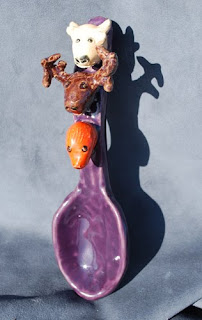 My attempt at copying these slippery, beady-eyed fish with the big brush was not so impressive. It amazes me how sumi-e' can look so simple and yet be so difficult to do well. My inky fish slipped off the big brush, slug-like and lacking the lively flip and flop of this yin yang pair. Tomorrow, for my lesson on line, I will encourage my students to capture the essence of an animal in a few simple strokes with a small bamboo brush and india ink. I know the results will amaze me; they always do!
My attempt at copying these slippery, beady-eyed fish with the big brush was not so impressive. It amazes me how sumi-e' can look so simple and yet be so difficult to do well. My inky fish slipped off the big brush, slug-like and lacking the lively flip and flop of this yin yang pair. Tomorrow, for my lesson on line, I will encourage my students to capture the essence of an animal in a few simple strokes with a small bamboo brush and india ink. I know the results will amaze me; they always do!I love the red, rectangular stamp signatures on asian scrolls. I have some strips of thin foam material which the students can cut and stick on cardboard to create simple stamps. While they work on their individual 'signature' stamps I will invite a student at a time to take up the big brush to swish and swoosh an 'S' of a fish on a long strip of butcher paper; together we will slip and drip some inky fish into a river edged in red print symbols.






